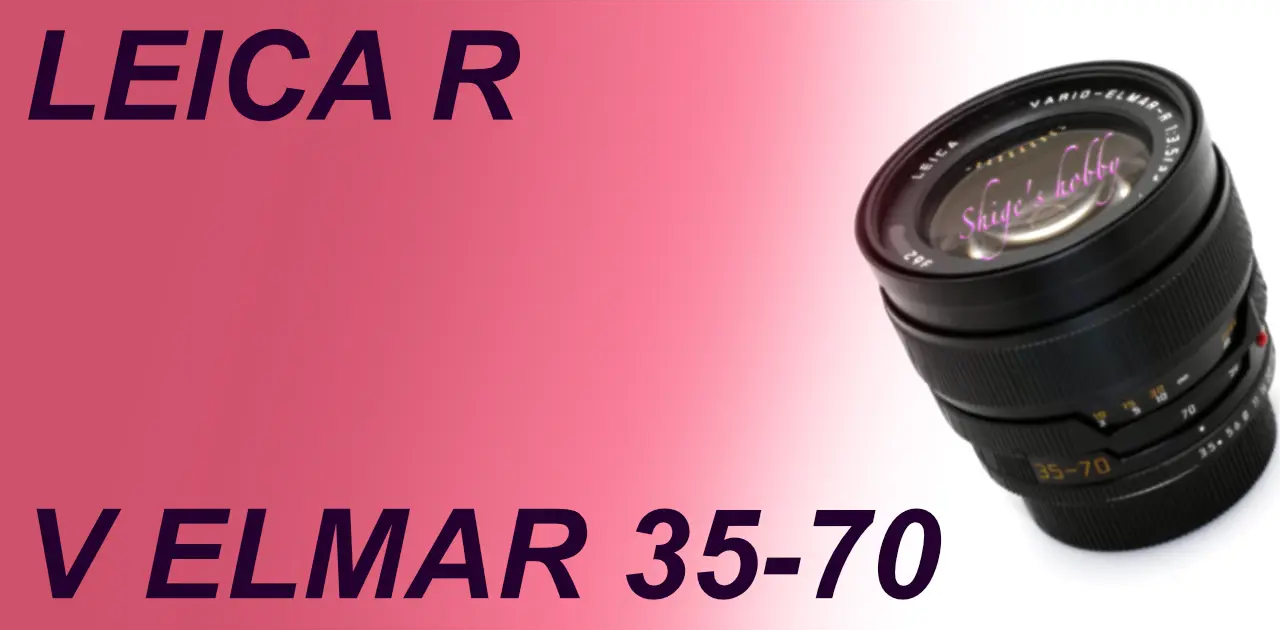Leica R Standard Zoom Lens VARIO ELMAR R 35-70mm F3.5

A review and sample photos using the LEICA VARIO ELMAR R 35-70mm F3.5 with a LEICA R8 + LEICA Digital Module R and a CANON EOS 1Ds Mk-III.
- Please see the disclaimer regarding advertising here.
- Italicized links in the text are advertisement links that take you to other sites.
Table of contents

Gallery
The sample photos were taken with the LEICA Digital Module R +LEICA R8 and CANON EOS-1Ds MK-III.
Review
1.Overview
The LEICA VARIO ELMAR R 35-70mm f/3.5 is a 2x zoom lens for the Leica R, manufactured in both Japan and Germany.
With approximately 31,000 units produced, a considerable quantity is available on the market.
The minimum focusing distance is 1m at all focal lengths, the aperture has six blades, and a built-in hood.
Models manufactured from 1982, when the lens was first released, through 1985 had a 60mm filter diameter and were made in Japan (MADE IN JAPAN), while models manufactured from 1986 to 1997 had a 67mm filter diameter and were manufactured in Germany by ELW (Ernst Leitz Wetzlar). Since there is no information indicating any design changes after production moved to Germany, it is believed that the lens continued to use the original Minolta-designed optics.
The original optics are said to be from the Minolta MD 35-70 f/3.5 zoom (1978).
2.Usability
Looking at the results of shooting with the LEICA VARIO ELMAR R 35-70mm F3.5, when using the Digital Module R (DMR) to convert the film cameras LEICA R8 and LEICA R9 into digital cameras, the DMR’s sensor size is APS-H (30.2 x 16.7mm), which is smaller than 35mm format, so the peripheral areas are forcibly cut off (cropped), changing the focal length. The DMR’s conversion factor to 35mm format is 1.37, so multiplying the original focal length of 35-70mm by 1.37 results in a zoom lens covering standard to telephoto focal lengths equivalent to 48-96mm.
Although it’s an old zoom, the DMR’s 10 megapixels provide sufficient resolution and decent foreground and background bokeh, making it usable without any problems.
When used with the Canon EOS-1Ds MK-III, which is equipped with a 20-megapixel 35mm full-frame sensor, the image is not as sharp across the entire range as modern lenses, but the slightly dull feel is tolerable for a budget zoom lens.
Also, because the rear element of this lens is not close to the film and sensor, the Err01 error that occurs when the lens interferes with the body’s sensor when used with the Canon EOS-1Ds MK-III does not appear, and the lens can be used without any issues.
In terms of operation, the lens is like an old-fashioned zoom lens, where the length changes when focusing and zooming. When retracted, the focal length is 70mm at the telephoto end, and at a focal length of 35mm, the front lens element juts out, creating a large waist in the center of the lens. The lens has a rather unusual appearance. I didn’t take any photos of it because I didn’t particularly like the look, but you can see what it looks like by using an image search or similar.
The focus ring is located at the front of the lens, so there is no problem with focusing at a focal length of 70mm, but when you change the focal length to 35mm, you have to turn the tip of the extended lens, which makes the image unbalanced when shooting.
3.Summary
In conclusion, to sum up the LEICA VARIO ELMAR R 35-70mm F3.5 is a zoom lens with a Japanese-made Leica badge. It has the same specifications as an old zoom lens that sells for several thousand yen if it has a Japanese manufacturer’s badge. Thanks to the Leica badge, it sells for about 10 times that price, so it’s not a lens worth buying in the 2020s.
Specifications, considerations, etc.
R-mount zoom lenses make heavy use of Japanese technology, and the successor to this lens, the Vario-Elmar 35-70mm F4, is said to be manufactured by Kyocera. I once owned this lens, and it has evolved into a slightly more convenient zoom lens, as you can get closer to the subject by extending the lens with the macro button.
Other R-mount zoom lenses are also quite diverse, including those made by Sigma. Even with the transition to the LEICA L-mount, Japanese-made zoom lenses, such as those made by Konica Minolta, Panasonic, and Sigma, still dominate the market.
| Item | Value | note |
| focal length(mm) | 35-70 | |
| Maximum aperture | 3.5 | |
| Minimum aperture | 22 | |
| Lens configuration | 7groups 8elements | |
| Leaf blade | 6 | |
| Minimum distance(m) | 1.0 | |
| Lens length(mm) | 64.5 | Distance form mount frange |
| Lens max diameter(mm) | 72 | |
| Filter diameter(mm) | 67(New-ver) | 60mm(Old-ver) |
| Weight(g) | 450 | |
| Release date | Year 1982 | Product end y1997 |
Reference links
Affiliate link
- Leica lens・Ads by Amazon
- Leica digital・Ads by Amazon
- Leica camera body・Ads by Amazon
- Leica accessory・Ads by Amazon
- Leica book・Ads by Amazon

Update history
- 2025.10.2
- 2025.1.12
- 2024.02.16:Update article
- 2022.02.20:First draft
Leave a Reply